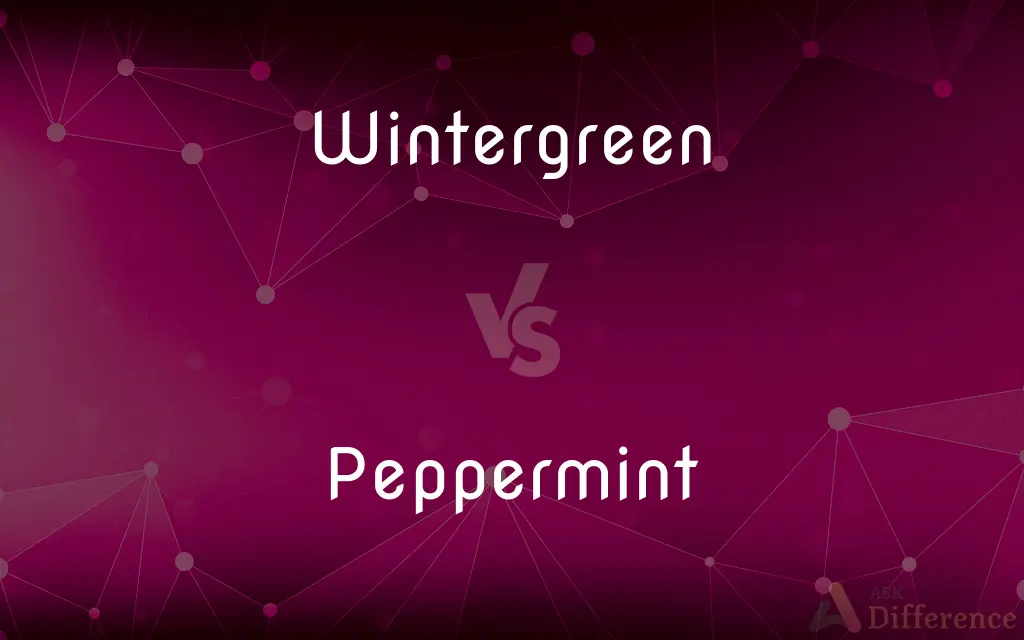Wintergreen vs. Peppermint — What's the Difference?
Edited by Tayyaba Rehman — By Fiza Rafique — Updated on March 31, 2024
Wintergreen offers a sweet, medicinal flavor, while peppermint provides a cooling, fresh taste.

Difference Between Wintergreen and Peppermint
Table of Contents
ADVERTISEMENT
Key Differences
Wintergreen, known for its sweet yet medicinal flavor, is derived from the leaves of plants in the genus Gaultheria. Its characteristic taste and aroma come from methyl salicylate, which is used both as a flavoring agent and in pain relief ointments. Peppermint, on the other hand, is known for its fresh, cool taste and is derived from the peppermint plant (Mentha piperita). Its main component, menthol, contributes to its cooling sensation and is widely used in culinary, cosmetic, and medicinal products.
Wintergreen's uses are often medicinal, reflecting its soothing properties for pain relief and muscle aches, thanks to the high concentration of methyl salicylate. It's also found in some traditional candies and chewing gums, offering a sweet, cooling taste. Peppermint's uses are more varied, spanning from culinary applications in teas, candies, and desserts, to therapeutic uses in aromatherapy and as a digestive aid, showcasing its versatility and refreshing flavor profile.
The aroma of wintergreen is distinctly sweet with a medicinal hint, making it recognizable in many ointments and topical creams. This aroma lends a warming sensation when applied to the skin. Conversely, peppermint's aroma is intensely fresh and cooling, making it a favorite for invigorating the senses, relieving nasal congestion, and even deterring pests.
In terms of cultivation, wintergreen is typically found in North America's wooded areas, thriving in shaded, organic-rich soils. This plant prefers cooler climates and is often harvested for its leaves, which contain the oil used in flavorings and medicinal products. Peppermint is a hardy perennial that grows well in a variety of climates but prefers moist, fertile soil. It is cultivated worldwide for its essential oil, which is extracted from the leaves and used in numerous products.
Despite their differences, both wintergreen and peppermint share a place in natural remedies and flavorings. Their distinct tastes and aromas contribute uniquely to food, cosmetics, and medicinal products, showcasing the diversity of natural flavors and their applications in everyday life.
ADVERTISEMENT
Comparison Chart
Flavor
Sweet, medicinal
Cooling, fresh
Derived From
Leaves of Gaultheria species
Peppermint plant (Mentha piperita)
Main Component
Methyl salicylate
Menthol
Uses
Medicinal, some candies and gums
Culinary, cosmetic, medicinal, aromatherapy
Aroma
Sweet, medicinal, warming
Fresh, cooling
Cultivation Area
North America, shaded, organic-rich soil
Worldwide, moist, fertile soil
Compare with Definitions
Wintergreen
Grows in shaded, organic-rich soils in cooler climates.
Wintergreen thrives in the understory of North American forests.
Peppermint
Versatile in culinary, cosmetic, and medicinal uses.
Peppermint is used in everything from toothpaste to desserts.
Wintergreen
Derived from the Gaultheria species.
The leaves of wintergreen plants are harvested for their oil.
Peppermint
Comes from the Mentha piperita plant.
Peppermint fields are harvested for their aromatic leaves.
Wintergreen
High in methyl salicylate.
Methyl salicylate in wintergreen acts as a natural analgesic.
Peppermint
Contains a high concentration of menthol.
The menthol in peppermint oil provides a cooling sensation.
Wintergreen
Used in medicinal products and some confections.
Traditional wintergreen candies are a favorite holiday treat.
Peppermint
Adaptable to various climates, prefers moist, fertile soil.
Peppermint cultivation is widespread, benefiting from regular watering.
Wintergreen
Offers a sweet yet medicinal flavor.
Wintergreen oil is popular in natural pain relief remedies.
Peppermint
Known for its cooling, fresh taste.
Peppermint tea is a popular remedy for digestive discomfort.
Wintergreen
Wintergreen is a group of aromatic plants. The term "wintergreen" once commonly referred to plants that remain green (continue photosynthesis) throughout the winter.
Peppermint
Peppermint (Mentha × piperita, also known as Mentha balsamea Wild) is a hybrid mint, a cross between watermint and spearmint. Indigenous to Europe and the Middle East, the plant is now widely spread and cultivated in many regions of the world.
Wintergreen
A creeping evergreen North American plant (Gaultheria procumbens) in the heath family, having solitary nodding white flowers, aromatic leaves, and spicy edible scarlet berries. Also called checkerberry, teaberry.
Peppermint
A hybrid perennial plant (Mentha ×piperita) in the mint family, having small purple or white flowers and downy leaves that yield a pungent oil used as a flavoring and in some medicinal preparations.
Wintergreen
An oil or flavoring obtained from this plant or certain other plants, such as sweet birch, or produced synthetically.
Peppermint
A candy or lozenge flavored with oil from this plant.
Wintergreen
Any of several similar or related plants, especially the pipsissewas and plants of the genus Pyrola.
Peppermint
A hybrid herb of the mint family (Mentha × piperita), formed by crossing watermint and spearmint, which has a high menthol content and a sharp flavor and is used in cooking, especially in herb teas and in confections.
Wintergreen
(obsolete) Any evergreen plant.
Peppermint
(countable) A confection containing extract of peppermint.
Wintergreen
One of various not closely related evergreen plants, including:
Peppermint
An aromatic and pungent plant of the genus Mentha (Mentha piperita), much used in medicine and confectionery.
Wintergreen
Plants in shrub genus Gaultheria, commonly known as wintergreen, especially:
Peppermint
A volatile oil (oil of peppermint) distilled from the fresh herb; also, a well-known essence or spirit (essence of peppermint) obtained from it.
Wintergreen
Plants in any of several other genera in the herbaceous family Ericaceae, including:
Peppermint
A lozenge of sugar flavored with peppermint.
Wintergreen
Some species of the herbaceous genus Trientalis, in family Primulaceae (chickweed wintergreen)
Peppermint
Herb with downy leaves and small purple or white flowers that yields a pungent oil used as a flavoring
Wintergreen
The spicy red berries of Gaultheria procumbens.
Peppermint
Red gum tree of Tasmania
Wintergreen
The oil, methyl salicylate, obtained from these berries.
Peppermint
A candy flavored with peppermint oil
Wintergreen
The aroma of the oil, methyl salicylate, however derived.
Wintergreen
A plant which keeps its leaves green through the winter.
Wintergreen
Any of several evergreen perennials of the genus Pyrola
Wintergreen
Creeping shrub of eastern North America having white bell-shaped flowers followed by spicy red berrylike fruit and shiny aromatic leaves that yield wintergreen oil
Wintergreen
Spicy red berrylike fruit; source of wintergreen oil
Common Curiosities
How are the aromas of wintergreen and peppermint different?
Wintergreen's aroma is sweet and warming, often found in ointments, while peppermint's aroma is intensely fresh and cooling.
Can both wintergreen and peppermint be used medicinally?
Yes, both are used medicinally; wintergreen for its pain-relieving properties and peppermint for digestive aid and nasal congestion relief.
What are the main components of wintergreen and peppermint oils?
Wintergreen oil mainly contains methyl salicylate, and peppermint oil is rich in menthol.
What distinguishes wintergreen's flavor from peppermint's?
Wintergreen has a sweet, medicinal flavor due to methyl salicylate, while peppermint is known for its fresh, cooling taste from menthol.
Are wintergreen and peppermint flavors interchangeable in recipes?
Not typically, as their flavors and sensations are distinct; wintergreen is sweet and medicinal, whereas peppermint is cool and refreshing.
Where do wintergreen and peppermint typically grow?
Wintergreen grows in North America's cooler, shaded areas, while peppermint is cultivated worldwide in moist, fertile soils.
Can wintergreen and peppermint be used in cosmetics?
Yes, both are used in cosmetics; wintergreen for its soothing properties and peppermint for its refreshing sensation.
Is wintergreen oil used in food products?
Yes, though less commonly than peppermint, wintergreen oil is used in some candies and chewing gums.
How does menthol in peppermint affect the body?
Menthol provides a cooling sensation, which can soothe digestive tract muscles and relieve nasal congestion.
What is a common medicinal use for peppermint?
Peppermint is commonly used as a digestive aid and to relieve nasal congestion.
What types of products commonly contain peppermint?
Peppermint is found in a wide range of products, including teas, candies, digestive aids, toothpaste, and aromatherapy oils.
Can peppermint help with headaches?
Yes, peppermint oil is often used in aromatherapy to relieve tension headaches due to its cooling effect.
Why is wintergreen considered medicinal in flavor?
Its flavor comes from methyl salicylate, which is similar to aspirin and used for pain relief, giving it a medicinal quality.
Is wintergreen oil safe for all uses?
Wintergreen oil should be used cautiously, as methyl salicylate is potent and can be toxic in high quantities.
What should be considered when growing wintergreen or peppermint?
Wintergreen requires shaded, organic-rich soil and cooler climates, while peppermint thrives in moist, fertile soil and is more adaptable to various climates.
Share Your Discovery

Previous Comparison
Aristocrat vs. Gentry
Next Comparison
Meek vs. SubservientAuthor Spotlight
Written by
Fiza RafiqueFiza Rafique is a skilled content writer at AskDifference.com, where she meticulously refines and enhances written pieces. Drawing from her vast editorial expertise, Fiza ensures clarity, accuracy, and precision in every article. Passionate about language, she continually seeks to elevate the quality of content for readers worldwide.
Edited by
Tayyaba RehmanTayyaba Rehman is a distinguished writer, currently serving as a primary contributor to askdifference.com. As a researcher in semantics and etymology, Tayyaba's passion for the complexity of languages and their distinctions has found a perfect home on the platform. Tayyaba delves into the intricacies of language, distinguishing between commonly confused words and phrases, thereby providing clarity for readers worldwide.
















































